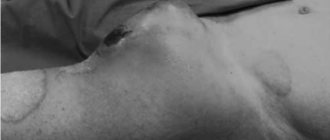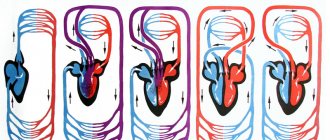Pulmonary hypertension is a disease in which blood pressure in the pulmonary artery increases by 20 mmHg. or more at rest and more than 30 mm Hg. under loads. In terms of frequency, this disease is in third place among cardiovascular diseases in people over the age of 30 (the first and second places are occupied by ischemic heart disease and arterial hypertension, respectively).
- Causes and pathogenesis
- Symptoms and diagnosis
- Treatment of pulmonary hypertension
- Forecast
Causes and pathogenesis
Pulmonary hypertension is divided into congenital and acquired. Otherwise, these forms are called primary and secondary. Among the causes of increased pressure in the pulmonary artery are the following:
- chronic lung diseases (bronchial asthma, COPD, sarcoidosis, interstitial pulmonary fibrosis, tuberculosis, silicosis, asbestosis)
- heart diseases (heart failure, acquired and congenital heart defects)
- stay in the highlands
- vasculitis
- effects of drugs on the body
- TELA
Pulmonary hypertension without a known cause is called primary hypertension. The cause of PH may be an increase in pressure in the pulmonary veins. Growth is provoked by the following factors:
- left ventricular failure
- mitral valve defects
- pulmonary vein compression
- left atrium myxomas
Increased pulmonary blood flow can also trigger pulmonary hypertension:
- patent ductus arteriosus
- ventricular septal defect
- atrial septal defect
Among the causes of the disease in question is an increase in pulmonary vascular resistance, which can be caused by:
- taking drugs that reduce appetite (fenfluramine) or chemotherapy drugs
- obstruction of the pulmonary artery and its branches
- inflammatory changes in the lung parenchyma
- destruction of the pulmonary vascular bed (with chronic destructive lung diseases, pulmonary emphysema)
- chronic alveolar hypoxia (for example, when staying high in the mountains)
Valvular defects lead to the occurrence of passive PH as a result of the transfer of pressure from the left atrium to the pulmonary veins and then to the pulmonary artery system. With mitral orifice stenosis, there can sometimes be a reflex spasm of the pulmonary arterioles due to increased pressure at the mouths of the pulmonary veins and in the left atrium. Long-term development of PH leads to irreversible sclerotic changes in arterioles and their obliteration.
If a person has congenital heart defects, PH results from increased blood flow in the pulmonary artery system and resistance to blood flow in the pulmonary vessels. Left ventricular failure, which occurs with dilated cardiomyopathy, coronary heart disease, and hypertension, can also cause pulmonary hypertension because the left atrium and pulmonary veins become higher than normal.
In chronic diseases of the respiratory organs, PH for a long period of time has a compensatory nature, because hypoxic pulmonary vasoconstriction turns off non-ventilated areas of the lungs from perfusion, which eliminates the shunting of blood in them, and hypoxemia decreases. At this stage, the use of a drug such as aminophylline reduces pressure in the pulmonary circulation, reduces compensatory vasostriction, and reduces intrapulmonary shunting of blood with deterioration of oxygenation. As lung disease progresses, PH becomes a factor in the pathogenesis of the formation of chronic “pulmonary heart.”
Common truncus arteriosus
The name of this rare heart defect defines its essence. Instead of two main vessels—the aorta and the pulmonary artery—from the heart, one large vessel departs, carrying blood into the systemic circulation, into the lungs and coronary vessels. This vessel - the arterial trunk - did not divide, as it should, at 4-5 weeks of intrauterine life of the fetus, into the aorta and pulmonary artery, but “sitting” astride the two ventricles, carries mixed blood into both circles of blood circulation (the ventricles communicate with each other through huge ventricular septal defect). The pulmonary arteries to both lungs can depart from the trunk in one common vessel (and then divide into branches) or separately, when both the right and left depart directly from the trunk.
It is clear that with this defect the entire circulatory system is deeply disturbed. The flow of venous and arterial blood mixes in the ventricles. This oxygen-undersaturated mixture enters the systemic circle and the lungs under the same pressure, and the heart works with enormous load. Manifestations of the defect become obvious already in the first days after birth: shortness of breath, fatigue, sweating, cyanosis, rapid pulse, enlarged liver - in a word, all signs of severe heart failure. These phenomena may decrease in the first months of life, but in the future they will only increase. In addition, the response of the pulmonary vessels to increased blood flow leads to their changes, which will very soon become irreversible. According to statistics, 65% of children with a common arterial trunk die during the first 6 months of life, and 75% do not live to see their first birthday. For patients, even those who have reached only two or three years of age, it is usually too late to operate, although they can live up to 10-15 years.
Surgical treatment is quite possible, and its results are quite good. The most important condition for success will be the timely admission of the child to a specialized cardiology center and the performance of the operation in the first months of life. Delay in these cases is like death.
If for some reason it is impossible to perform a radical operation, then a palliative option exists and has proven itself: applying a cuff to both pulmonary arteries arising from the common trunk. This operation (see the chapter on ventricular septal defects) will protect the pulmonary vessels from increased blood flow, but it must be done very early - in the first months of life.
Radical correction of the common arterial trunk is a major intervention, performed, of course, under artificial circulation. The arteries leading to the lungs are cut off from the common trunk, thus turning the trunk only into the ascending aorta. Then the cavity of the right ventricle is incised, and the septal defect is closed with a patch. The normal path for left ventricular blood has now been restored. The right ventricle is then connected to the pulmonary arteries using a conduit. A conduit is a synthetic tube of one or another diameter and length, in the middle of which a biological or (less often) mechanical prosthesis of the valve itself is sewn. We discussed the various designs of artificial valves and their disadvantages and advantages above (see the chapter on Ebstein's anomaly). Let's just say that as it grows, the entire sewn-in conduit can grow with its own tissue and be destroyed, and the valve can gradually become overgrown and poorly cope with its original function. In addition, the size of the conduit that can be sewn into a six-month-old child is clearly insufficient to function normally for many years: after all, synthetic tubes and artificial valves do not grow. And, no matter how large the conduit is, after a few years it will become relatively narrow. In this case, over time the question of replacing the conduit will arise, i.e. about a repeat operation, but this can happen after many years of the child’s normal life. However, the need for constant and regular cardiac monitoring should be obvious to you.
It is possible that by the time you read this, they will have already created prostheses coated on the inside with their own cells, taken in advance from the child’s tissues. For now, this is only experimental work and it will take time for it to become a clinical reality. But with today’s dizzying pace of scientific development, this is quite possible in the near future.
How to get treatment at the Scientific Center named after. A.N. Bakuleva?
Online consultations
Symptoms and diagnosis
The main manifestation of pulmonary hypertension is shortness of breath, which has the following features:
- noted when a person is at rest, physically passive
- increases even with little physical activity
- noted even when the person is sitting (cardiac dyspnea does not have this feature)
Patients with pulmonary hypertension may also have the following symptoms:
- Dry (non-productive) cough
- Fast fatiguability
- Edema of the lower extremities
- Chest pain (caused by dilation of the pulmonary artery and right ventricular myocardial ischemia)
- Pain in the area of the right hypochondrium
- In some cases, the voice is hoarse because the nerve is compressed by the dilated trunk of the pulmonary artery and the recurrent laryngeal nerve.
- Syncope during exercise is likely because the right ventricle cannot increase cardiac output to meet the demands of the body, which increase with exercise.
During examination, the doctor notes cyanosis, which occurs due to reduced cardiac output and arterial hypoxemia. Pulmonary cyanosis differs from cardiac cyanosis by peripheral vasodilation, which is caused by hypercapnia, which explains the warmth of the patients' upper extremities. Also likely to be detected during examination are pulsations in the second intercostal space to the left of the sternum, which is associated with the trunk of the pulmonary artery; pulsations in the epigastric region associated with a hypertrophied right ventricle.
With severe heart failure, examination reveals swelling of the jugular veins both during exhalation and inhalation, which is a typical manifestation of right ventricular heart failure. Hepatomegaly and peripheral edema are also detected.
Auscultation of the heart reveals the following signs:
- Fixed second tone splitting
- Systolic click and accent of the second tone over the pulmonary artery
- Systolic murmur is heard in the projection of the 3-leaf valve as a result of its insufficiency
- In the second intercostal space to the left of the sternum - systolic ejection murmur
If pulmonary hypertension is suspected, a diagnostic method such as X-ray examination is also used. It makes it possible to detect the expansion of the pulmonary artery trunk and the roots of the lungs. PH is manifested by dilatation of the right descending branch of the pulmonary artery by more than 16-20 mm.
ECT may show changes as a result of the following factors:
- turning the heart
- pulmonary hypertension
- cardiac disposition due to emphysema
- myocardial ischemia
- changes in blood gas composition
- metabolic disorders
If the electrocardiogram is normal, the diagnosis of pulmonary hypertension cannot be rejected. Signs of right ventricular hypertrophy, deviation of the electrical axis of the heart to the right, etc. may be detected.
Echocardiography may reveal thickening of the right ventricular wall and dilation of the right atrium and right ventricle. Also, using this method, the pressure in the right ventricle and the pulmonary artery trunk is determined using the Doppler method.
Catheterization of the cardiac cavities and direct manometry are reliable methods for diagnosing the disease in question. They can detect an increase in pressure in the pulmonary artery, while the pulmonary artery wedge pressure remains low or below normal.
PULMONARY TRUNK AND ITS BRANCHES. STRUCTURE OF THE AORTA AND ITS BRANCHES
Pulmonary trunk
(truncus pulmonalis) is divided into the right and left pulmonary arteries. The site of division is called the bifurcation of the pulmonary trunk (bifurcatio trunci pulmonalis).
Right pulmonary artery
(a. pulmonalis dextra) enters the gate of the lung and divides. In the upper lobe there are descending and ascending posterior branches (rr. posteriores descendens et ascendens), apical branch (r. apicalis), descending and ascending anterior branches (rr. anteriores descendens et ascendens). In the middle lobe there are medial and lateral branches (rr. lobi medii medialis et lateralis). In the lower lobe there is the upper branch of the lower lobe (r. superior lobi inferioris) and the basal part (pars basalis), which is divided into four branches: anterior and posterior, lateral and medial.
Left pulmonary artery
(a. pulmonalis sinistra), entering the gate of the left lung, divides into two parts. To the upper lobe there are ascending and descending anterior (rr. anteriores ascendens et descendens), lingual (r. lingularis), posterior (r. posterior) and apical branches (r. apicalis). The superior branch of the inferior lobe goes to the lower lobe of the left lung, the basal part is divided into four branches: anterior and posterior, lateral and medial (as in the right lung).
Pulmonary veins
originate from the capillaries of the lung.
The right inferior pulmonary vein (v. pulmonalis dextra inferior) collects blood from five segments of the lower lobe of the right lung. This vein is formed by the confluence of the superior vein of the lower lobe and the common basal vein.
The right superior pulmonary vein (v. pulmonalis dextra superior) collects blood from the upper and middle lobes of the right lung.
The left inferior pulmonary vein (v. pulmonalis sinistra inferior) collects blood from the lower lobe of the left lung.
The left superior pulmonary vein (v. pulmonalis sinistra superior) collects blood from the upper lobe of the left lung.
The right and left pulmonary veins drain into the left atrium.
Aorta
(aorta) has three sections: the ascending part, the arch and the descending part.
Ascending aorta
(pars ascendens aortae) has an extension in the initial section - the aortic bulb (bulbus aortae), and at the location of the valve - three sinuses.
Aortic arch
(arcus aortae) originates at the level of the articulation of the second right costal cartilage with the sternum; has a slight narrowing, or isthmus of the aorta (isthmus aortae).
Descending aorta
(pars descendens aortae) begins at the level of the IV thoracic vertebra and continues to the IV lumbar vertebra, where it divides into the right and left common iliac arteries. In the descending part, the thoracic (pars thoracica aortae) and abdominal parts (pars abdominalis aortae) are distinguished.
Treatment of pulmonary hypertension
Therapy depends on the cause that led to the development of pulmonary hypertension. It must be remembered that the pressure in the pulmonary artery may exceed normal due to the following factors:
- physical exercise
- hypothermia
- pregnancy
- stay in the highlands
The condition of a person with pulmonary hypertension can be alleviated by inhaling oxygen. But it is contraindicated for those who have right-to-left shunting and arterial hypertension.
In chronic nonspecific lung diseases, pulmonary hypertension can be reduced with the help of such medications6
- slow calcium channel blockers
- aminophylline
- nitrates
But they do not affect the life expectancy of people with PH, which was proven by studies no more than 20-30 years ago. It is possible to reduce PH and increase life expectancy with long-term low-flow oxygen therapy.
Taking diuretics reduces the severity of right ventricular failure. But when prescribing, some caution is needed, because in patients with pulmonary hypertension, large diuresis can reduce the preload on the right ventricle and cardiac output will decrease. A relevant drug is furosemide, which is prescribed at a dose of 20-40 mg per day. Taken orally. Hydrochlorothiazide is also effective at a dose of 50 mg/day orally.
Slow calcium channel blockers are used to reduce pulmonary artery pressure in patients with established pulmonary hypertension. The effect is exerted by nifedipine at a dose of 30-240 mg/day or diltiazem at a dose of 120-900 mg/day.
Cardiac glycosides are not effective drugs for the treatment of patients with PH. They can be used in small doses for atrial fibrillation to slow the heart rate. It should be taken into account that in patients with PH, glycoside intoxication develops faster as a result of hypoxemia and hypokalemia during diuretic therapy.
If drug treatment does not produce results, lung or heart-lung transplantation is recommended.







